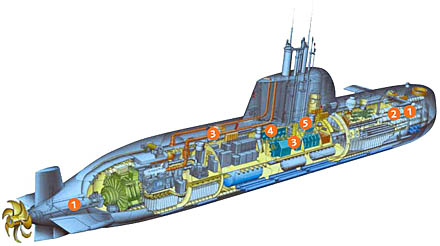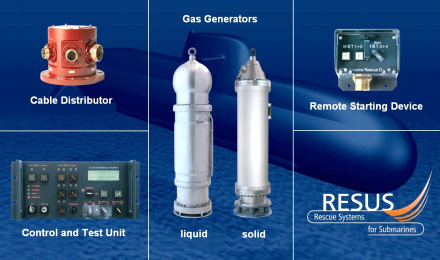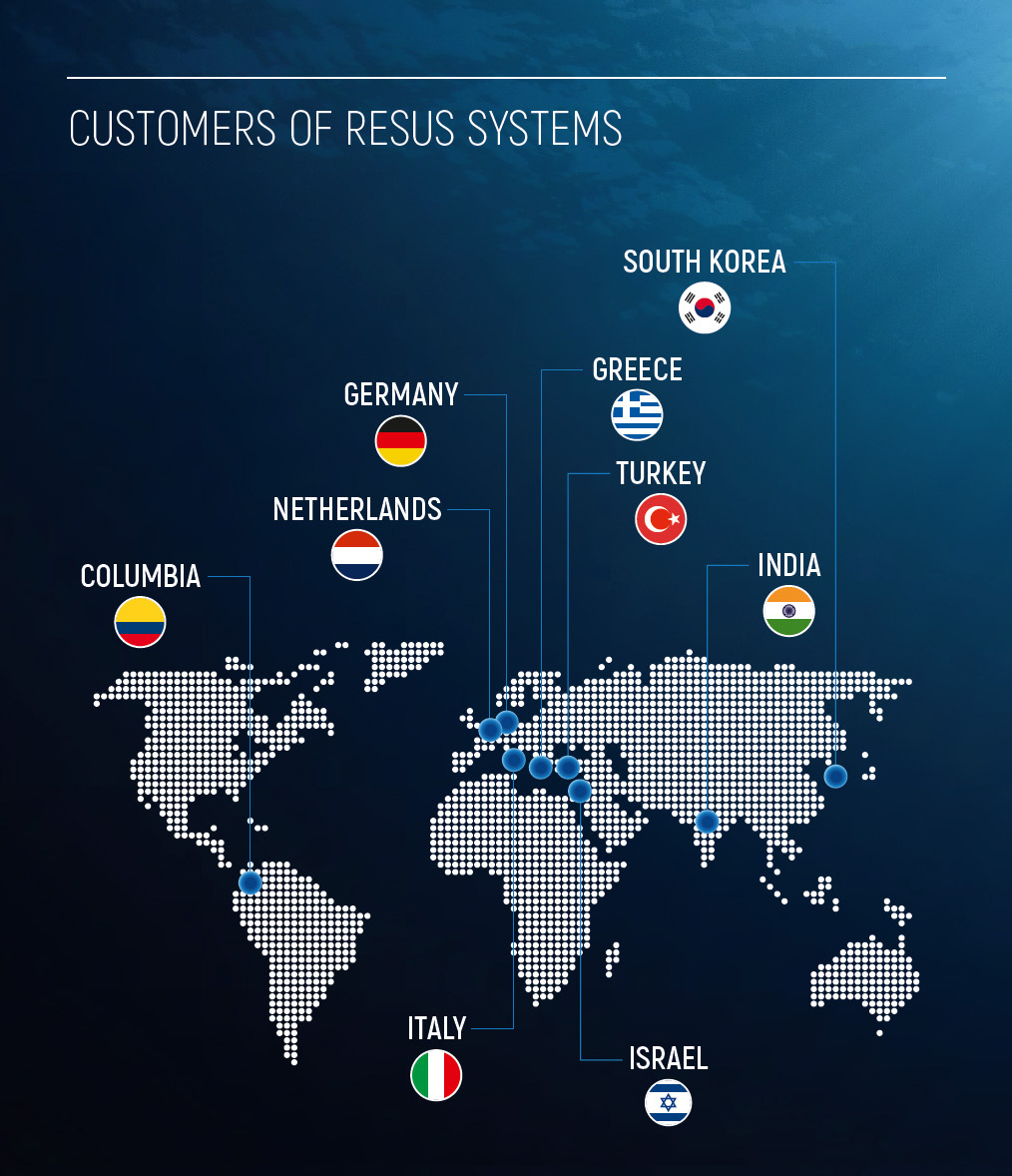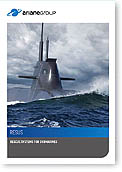
Submarine Rescue System
About RESUS
For over 40 years, RESUS (REscue system for SUbmarineS)
has been the standard rescue system on all German submarines, as well
as the submarines of other navies.
RESUS is more than a crew rescue system, since it enables the rapid
buoyancy and rescue of an entire submarine from any depth.
RESUS functions independently of all onboard systems and therefore
does not require electrical, mechanical, hydraulic or electrical
power. The rescue system can be set to either manual, or automatic
mode and can be initiated on demand and when the need arises.
The system provides a powerful and responsive safeguard to all kinds of
submarine emergency situations which are especially life threatening,
hazardous or potentially catastrophic when the craft is submerged.
Typical scenarios for RESUS include:
- Hydroplanes jammed in a diving position due to an irreparable hydraulics systems failure, or the effect of depth charges
- Failure, or unresponsive onboard manoeuvring system.
Outbreak of fire.
- Compartment flooding due to ruptured pressure hull.
- Prevention of a submarine sinking to its crush depth.
- Submerged collision.
How RESUS Works
Gas Generation
RESUS was developed from the space propulsion industry and exploits the stored chemical energy of propellants to rapidly generate pressurant gas. The gas generators may use liquid or solid propellants, depending on the required amount of gas, gas temperature and gas composition.
Working Principles
The working principle of the liquid propellant gas generators is based on the catalytic decomposition of hydrazine (N2H4) into a hot gas pressurant. The hydrazine is the same as that used in our hydrazine thrusters and
Propellant Tanks for a variety of space propulsion applications. The solid propellant gas generators produce pressurant gas by combustion. Both types of gas generator can be installed in any orientation, even upside down.
A synopsis of the complete RESUS Submarine Rescue System is
provided in this video.

RESUS Subsystems
Systems Description
RESUS is commanded from a Control and Test Unit located in the submarine control room. From the Control and Test Unit, an electrical cable harness terminates at a Cable Distributor. From the Cable Distributor, cables are routed via a feed-through between the pressure hull and main ballast tanks to the electrical connections of each of the gas generators. The standard configuration of gas generator is installed in the forward and aft main ballast tanks.
The gas generators are activated to ignite by an electrical signal from the Control and Test Unit. Activation is achieved by the opening of a pyro valve, when liquid fuel gas generators are installed, or an igniter, when solid fuel gas generators are installed. Once activated, the gas generation cannot be stopped, or reversed.
Remote Starting Devices are located in a number of positions along the boat enabling RESUS to be activated from more than one location.
The number of gas generators needed for rapid surfacing depends on:
- The class of the submarine i.e. its displacement.
- The actual diving depth.
- The volume of the main ballast tanks.
The required number of gas generators to be fired is determined by the Control and Test Unit which determines the diving depth measured by the Diving Depth Measuring Device.
Operation
Via the Control and Test Unit, the system can be operated in "Automatic Mode" where the system is automatically started when a predefined diving depth is exceeded. Alternatively, the system can be set to "Manual Mode", allowing the system operator to decide on when to use RESUS.
When the system is activated, the gas generators produce a hot gas that is cooled and directed by ducts to the top of the main ballast tanks. The very high pressure gas entering the main ballast tanks, rapidly evacuates the ballast water causing the submarine to become quickly buoyant. Subsequently, the submarine is stabilised, its attitude restored and the boat safely rises to the surface. The gas generators in the aft main ballast tanks stabilises the boat when surfaced.
Due to the high output pressure of the gas generators, RESUS enables surfacing from diving depths in excess of 400 m. At these diving depths, pressurised air systems are no longer effective so that RESUS provides the only option available for emergency surfacing. With this feature, RESUS is of special interest for navies operating submarines predominantly in deep water areas.
Maintenance, Inspection and Training
After 10 years the Gas Generators have to be refurbished at ArianeGroup. Maintenance and inspection of the other RESUS system components can be done by the submarine crew and at the navy shipyard. Dedicated test equipment and training courses for these tasks are provided by ArianeGroup. In addition, ArianeGroup offers simulator-based and certified training courses for the operational use of the system.
Protection Against Uncommanded Operation
The RESUS system is protected against uncommanded operation such as:
- Shock waves due to underwater explosion.
- Electromagnetic waves.
- Inadvertent operation by the crew.
Gas Generator Guarantee
ArianeGroup is able to guarantee the gas generators for a maintenance-free service life of 10 years. This high confidence level is based upon:
- Over 40 years experience of installed RESUS systems.
- World leading expertise and know-how in space propulsion technologies and propellants.
- The results of extensive testing, including submarine surfacing tests.
- The implementation of enhanced thermodynamic simulation into the systems design.
- The implementation of the highest design, manufacturing and quality standards demanded by the space industry.
A demonstration of water blow out under gas generator pressure can be found in this
video.
RESUS Heritage

International customers using the RESUS Submarine Rescue System
For over 40 years, RESUS has been standard equipment installed in all
German submarines and those of other nations. RESUS has been installed on the submarines classes
206A, 209-1200, 209-1400, 209-1500, 212A and 214 and can also be adapted to
serve in submarines having different geometries of ballast tanks.

|
RESUS Rescue Systems
for Submarines
(PDF Brochure)
|
RESUS Brochure (pdf)
This brochure is available to view online from where it may be downloaded.
Get the latest version of the free Adobe Acrobat
Reader

If you require the printed version of these brochures, or more detailed information about this product please
contact us.
See the complete list of our space propulsion
brochures available for download.







